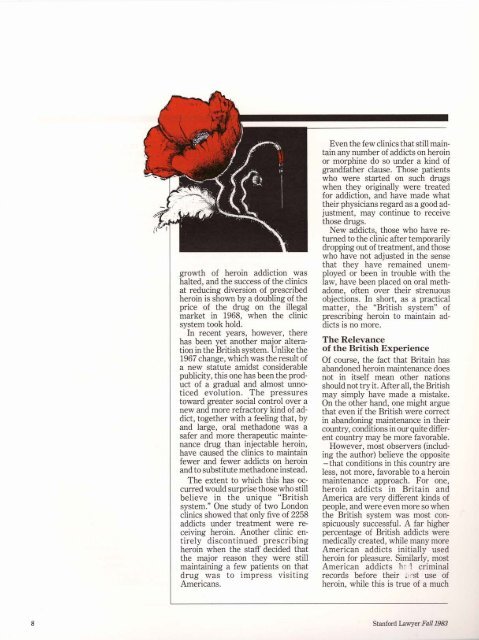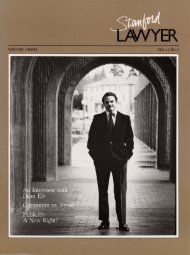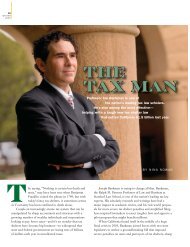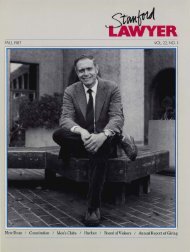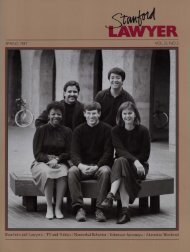growth of heroin addiction washalted, and the success of the clinicsat reducing diversion of prescribedheroin is shown by a doubling of theprice of the drug on the illegalmarket in 1968, when the clinicsystem took hold.In recent years, however, therehas been yet another major alterationin the British system. Unlike the1967 change, which was the result ofa new statute amidst considerablepublicity, this one has been the productof a gradual and almost unnoticedevolution. The pressurestoward greater social control over anew and more refractory kind of addict,together with a feeling that, byand large, oral methadone was asafer and more therapeutic maintenancedrug than injectable heroin,have caused the clinics to maintainfewer and fewer addicts on heroinand to substitute methadone instead.The extent to which this has occurredwould surprise those who stillbelieve in the unique "Britishsystem." One study of two Londonclinics showed that only five of 2258addicts under treatment were receivingheroin. Another clinic entirelydiscontinued prescribingheroin when the staff decided thatthe major reason they were stillmaintaining a few patients on thatdrug vvas to impress visitingAmericans.Even the few clinics that still maintainany number of addicts on heroinor morphine do so under a kind ofgrandfather clause. Those patientswho were started on such drugswhen they originally were treatedfor addiction, and have made whattheir physicians regard as a good adjustment,may continue to receivethose drugs.New addicts, those who have returnedto the clinic after temporarilydropping out of treatment, and thosewho have not adjusted in the sensethat they have remained unemployedor been in trouble with thelaw, have been placed on oral methadone,often over their strenuousobjections. In short, as a practicalmatter, the "British system" ofprescribing heroin to maintain addictsis no more.The Relevanceof the British ExperienceOf course, the fact that Britain hasabandoned heroin maintenance doesnot in itself mean other nationsshould not try it. After all, the Britishmay simply have made a mistake.On the other hand, one might arguethat even if the British were correctin abandoning maintenance in theircountry, conditions in our quite differentcountry may be more favorable.However, most observers (includingthe author) believe the opposite-that conditions in this country areless, not more, favorable to a heroinmaintenance approach. For one,heroin addicts in Britain andAmerica are very different kinds ofpeople, and were even more so whenthe British system was most conspicuouslysuccessful. A far higherpercentage of British addicts weremedically created, while many moreAmerican addicts initially usedheroin for pleasure. Similarly, mostAmerican addicts h~"'1 criminalrecords before their .-, rst use ofheroin, while this is true of a much8<strong>Stanford</strong> <strong>Lawyer</strong> <strong>Fall</strong> <strong>1983</strong>
smaller percentage of British addicts.White youths are overrepresentedamong British addicts, whileethnic minorities are overrepresentedamong American addicts.Another important but often-overlookedpoint is that medicine is practicedquite differently in the twonations. Heroin maintenance fitscomparatively well into an organizedsystem of health delivery such as theNational Health Service. Our presentanarchic medical system mayhave some advantages over socializedmedicine, but a number of commentatorson the British systemhave pointed out how much easier itis to care for heroin addicts in a clinicsetting where a wide variety of otherailments are also treated, and in asystem which also cares for themany health needs of addicts apartfrom their maintenance.Finally, the number of addicts inthe United States is so much largerthan the number that British heroinmaintenance has ever coped withthat the changes in the scale of theproblem might produce genuinedifferences in kind.In short, though the British experiencewith heroin maintenanceprovides us with a considerableamount of arguably relevant data, itis not very helpful in decidingwhether the United States should attemptsuch a system. Perhaps themost reliable conclusion we candraw is that our heroin problemswould probably be fewer today hadwe begun some kind of opiatemaintenance at the time we passedthe Harrison Act. Turning back theclock and starting from that point asecond time is obviously impossible,however, so we must consider thecosts and benefits of heroin maintenancein today's world.Heroin Maintenance OptionsHeroin maintenance is an extremelyplastic concept. As the British ex-perience indicates, relatively smallchanges in the method of implementation-such as the shift from prescriptionby private physicians tothat by specialized clinics - mayresult in very different consequences.Let us look at two quite differentways of maintaining addicts onheroin- the prescription system andthe use-on-the-premises system. Aswe will see, each of these has its ownproblems. Afterward we will examinethe more complex policyissues related to any governmentnarcotics maintenance program.The Prescription SystemAt the one extreme, we might followthe pre-1967 British system andsimply allow any private physician toprescribe heroin for the maintenanceof his addict patients. This measurewould be unlikely to work, since itfailed even in Britain. Rather thanopen ourselves to the charge of settingup a straw person, then, let usadopt, as our extreme, the model ofheroin maintenance that the Britishused in 1969, in the early stages ofthe clinics.Heroin clinics would prescribeheroin on the basis of the clinicphysician's assessment of the addict'sneed, and the addict thenwould pick up his supply at a pharmacyof his choice. Such a systemwould probably have a strong appealfor the great majority of addicts. Theamount of time and energy theywould have to spend in getting theirheroin would be vastly reduced, andthey would be using a safer and farcheaper drug.Many of the social costs of heroinprohibition would be lowered bysuch a system. A higher percentageof addicts would be able to stabilizetheir doses and become more productivecitizens. And even thosewho continued to steal would at leastnot have to meet the demands of anexpensive heroin habit. Moreover,the system would not be very expensiveto administer. The best recentestimate of the cost per addict isabout $2,500, or about one-fifthmore than a well-run methadoneprogram costs today.The Problem of LeakageThe prescription system, however,has one major and intractable disadvantage.Those addicts who pickup their supply of low-cost heroinwill have a strong incentive to resellat least part of their supply. Thisproblem is not a mere consequenceof sloppy administration. It is inherentin any system that allows theaddict to possess resellable heroinoutside the confines of a guardedclinic, laboratory, or hospital.Of course, the clinic staffwill try tolower the amount of heroin the addictcan sell by prescribing no morethan he needs. Several factors, however,make their task extremely difficult.First, it is impossible to tellhow much heroin an addict doesneed. Often he will be able to make aconvincing case that his tolerancehas increased his need.To complicate the matter further,today's heroin addicts have learnedhow to get along on wildly fluctuatingheroin dosages. Their intakevaries enormously when times ofheroin glut are succeeded by shortages,and even during periods ofstable price and supply, when theirincome changes. If the addict wishesto earn money by selling part of hisprescription, he can lower his use,either temporarily or permanently,and simply get along on less.In addition, since methadone willprobably remain available on thestreet at a lower price than heroin, itis likely that an addict would be ableto stave offwithdrawal by using thatdrug. This would allow 4im to sell all(continued on p. 61)<strong>Fall</strong> <strong>1983</strong> <strong>Stanford</strong> <strong>Lawyer</strong>9
- Page 1 and 2: RFAll 1983VOL. 18, NO.1Heroin Optio
- Page 3 and 4: jah(e,oYCONTENTSSTANFORD lAWYEREdit
- Page 5 and 6: Business Law vs. Public Interest La
- Page 7 and 8: By John Kaplanjockson Eli ReynoldsP
- Page 9: maintenance almost entirely up toth
- Page 14 and 15: that, because of regulation, cannot
- Page 16 and 17: of a whole variety of new mortgagei
- Page 18 and 19: ConversationsWith Five AlumniBy Mic
- Page 20 and 21: y landlords and tenants about rents
- Page 22 and 23: when I was studying law and she was
- Page 24 and 25: ~o(1)AtISSUE *Union 'Rights' in the
- Page 26 and 27: AtISSUECongressional Responses toSu
- Page 28 and 29: AtISSUEPrison Labor:TimeTo Take Ano
- Page 30 and 31: Graduates and friends of theSchool
- Page 32 and 33: ~o~ 4'-VVcYi~STATE OF THE SCHOOLJoh
- Page 34 and 35: ~o~ Cff-VIMtu'0r-STATE OF THE SCHOO
- Page 36 and 37: ~o~ 4-(/141~STATE OF THE SCHOOL con
- Page 38 and 39: ~o~4VJ41~SUCCESSFUL LAWYERING:IMPLI
- Page 40 and 41: ~o~of-VJM~SUCCESSFUL LAWYERING cont
- Page 42 and 43: @.oarcA 4l!141~THE CONSTITUTION, RA
- Page 44 and 45: @o~4t1J41~.LAW AND BUSINESS PROGRAM
- Page 46 and 47: @otwrA 4vJ41~ .SUMMARY AND ADVISORY
- Page 48 and 49: David L. Engel(Harvard, JD '73)Bost
- Page 50 and 51: New Faculty (cont.)Michigan Law Sch
- Page 52 and 53: GILSON (cant.)Gilson is currently p
- Page 54 and 55: BabcockAwarded anHonorary LL.D.by S
- Page 56 and 57: CAREER 'ALTERNATIVES' (cant.)2. A s
- Page 58 and 59: Hurlbut WinnerTalks AboutTeachingPr
- Page 60 and 61:
Schod;NI Grads Scatter toCities All
- Page 62 and 63:
FACULTV NOTES (cant.) Professor Gun
- Page 64 and 65:
it will be less so if we adopt a he
- Page 66 and 67:
than on its edges, thus increasing
- Page 68 and 69:
Heroin maintenance is, in manyways,
- Page 70 and 71:
c~OTESII1912-25Hon. David Lee Rosen
- Page 72 and 73:
c~NOTESthe firm advises, that "Donn
- Page 74 and 75:
c~NOTESand had been prominent in a
- Page 76 and 77:
spring Dean Ely traveledLEast, wher
- Page 78 and 79:
5Stanford LaWlers:This Page IsYours
- Page 80 and 81:
October 11Washington, DC LawSociety
- Page 82 and 83:
COMPARATIVE CONTRIBUTIONS TOTHE LAW
- Page 84 and 85:
A MESSAGE FROM THELAW FUND PRESIDEN
- Page 86 and 87:
CLASSAGENTSLong BeachSterling S. Cl
- Page 88 and 89:
Warren Christopher'49 Penny Howe Ga
- Page 90 and 91:
Frank L. Mallory '47Richard C. Mall
- Page 92 and 93:
Ronald G. Trayner '67Anthony J. Tre
- Page 94 and 95:
Walter A. Johnson, A.B. '29 Maxine
- Page 96 and 97:
DONORS TO THE LAW FUND• Hon. Murr
- Page 98 and 99:
CLASS OF 1948R. Winfield AchorHon.
- Page 100 and 101:
• Thomas R. MitchellR. Chandler M
- Page 102 and 103:
Paul E. Kreutz• Prof. Richard B.
- Page 104 and 105:
Gabriel M. GesmerMichael GilfixCorn
- Page 106 and 107:
HIGHEST LEVELSOF PARTICIPATIONLARGE
- Page 108 and 109:
FACULTY, FORMERFACULTY &STAFFBarbar
- Page 110 and 111:
REUNION GIVINGWhile class reunions
- Page 112 and 113:
DONORS TO SPECIALPROGRAMS AND FUNDS
- Page 114 and 115:
Class of 1954 Reunion Student Finan
- Page 116 and 117:
In Memory of:Clifton C. Cottrell '2
- Page 118 and 119:
Clyde E. Tritt'49William W. VaughnS
- Page 120:
BEQUESTS AND DEFERRED GIVINGBequest


